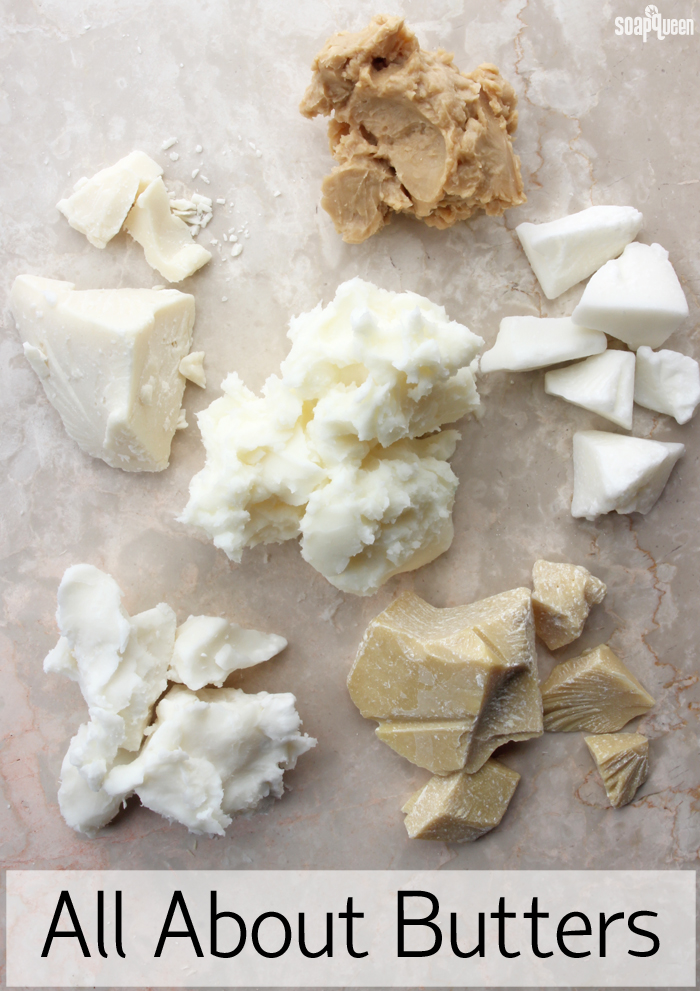
Rich, creamy and decadent, butters are a great addition to a wide variety of projects. They can be used in cold process soap, lip balms, body butters and more. They are solid at room temperature, and have varying textures. If you’re wondering what butter is right for your project, read more about mango, cocoa, coffee, shea and avocado butter below. Keep in mind that choosing a butter depends a lot on personal preference, and how you’d like your finished product to feel.
Before we look at the different kinds of butters, let’s talk about what butters have in common. Butters come from various natural sources, such as fruit trees and kernels. Some butters, such as coffee butter, are a blend of hydrogenated oils. Hydrogenation is the process of adding hydrogen to liquid oils to turn them into a solid. In general, butters are extremely skin loving and add a luxurious feel to products. In cold process soap, butters can contribute to the firmness of the bar. But, using too much butter can inhibit lather, or cause the soap to crack. In general, I like to use butters around 10%-15% or less in my recipes. To read more about various soap making oils and butters, click here.
Some butters are soft and spreadable, while others are hard and brittle. In my opinion, the softest butters are avocado butter and coffee butter. They are soft, spreadable and melt on contact with the skin. Shea butter is slightly firmer, but still soft and spreadable. The two harder butters are mango butter and cocoa butter. Both are more brittle, and need to be chopped rather than scooped. Cocoa butter is much firmer than mango, and is great for adding firmness to cold process soap. Do you have a favorite butter?
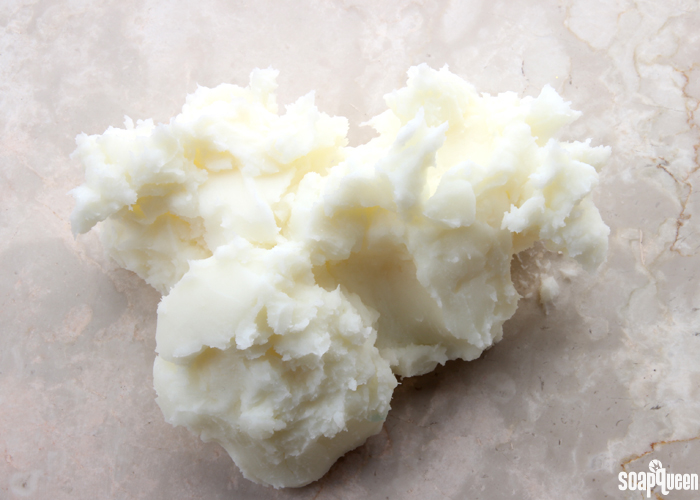 Avocado butter has a very soft and spreadable consistency. It’s manufactured from the fruit of the avocado tree, which normally grows in sub-tropical regions. Avocado butter is solid at room temperature, but melts when it comes in contact with skin. Its smooth texture and low melting point makes it easy to spread and whip, making it a great option for soft balms and whipped body butters.
Avocado butter has a very soft and spreadable consistency. It’s manufactured from the fruit of the avocado tree, which normally grows in sub-tropical regions. Avocado butter is solid at room temperature, but melts when it comes in contact with skin. Its smooth texture and low melting point makes it easy to spread and whip, making it a great option for soft balms and whipped body butters.
In cold process soap, I recommend using avocado butter up to 12.5% of your recipe (though I tend to use it at more of a 3-5% rate max). Avocado butter will contribute slightly to the firmness of the final bar of soap, but because it’s not an extremely firm butter it does not firm the soap like coconut oil, palm oil, wax or cocoa butter. It also isn’t going to contribute much to lather which is why my preference is to use it at a lower usage rate. It has a shelf life of about 3 years. Check out the recipes below that contain avocado butter for project ideas!
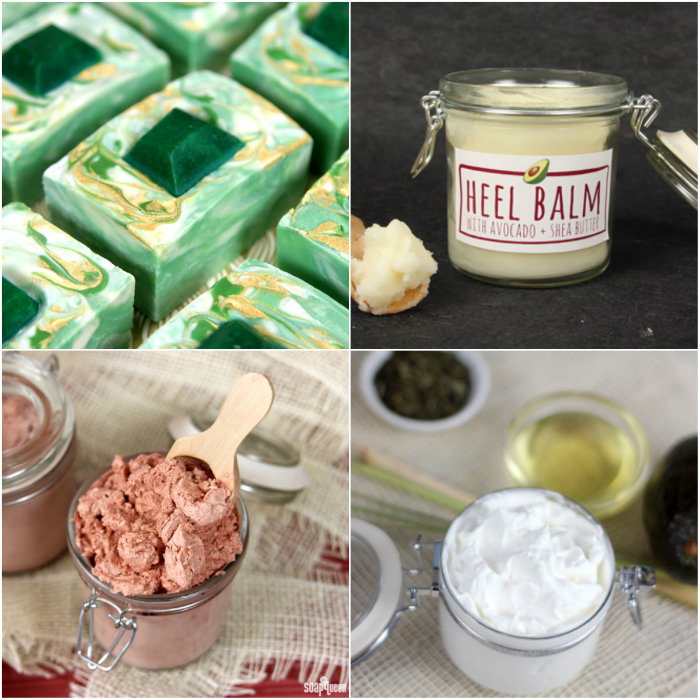 Top left, clockwise: Emerald Swirl Cold Process Tutorial, Moisturizing Heel Balm, How to Make Whipped Body Butter on Soap Queen TV, Whipped Amber Bronzing Butter
Top left, clockwise: Emerald Swirl Cold Process Tutorial, Moisturizing Heel Balm, How to Make Whipped Body Butter on Soap Queen TV, Whipped Amber Bronzing Butter
Cocoa Butter (Cocoa Butter Chunks, Cocoa Butter Pastilles & Deodorized Cocoa Butter)
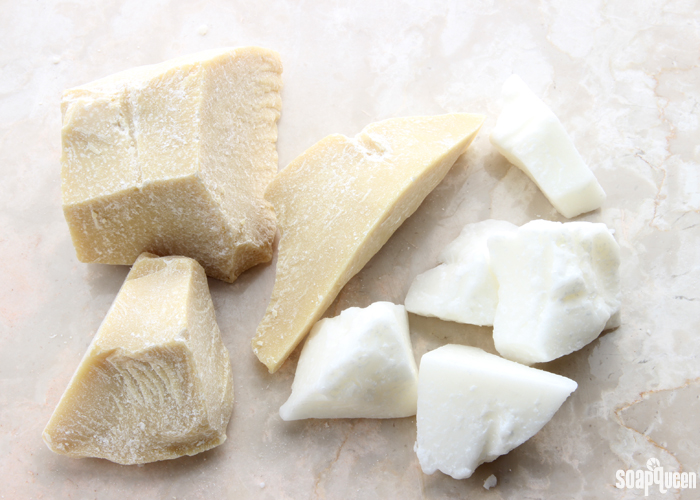 Cocoa butter is a vegetable fat with a creamy, chocolatey scent. It has a firm and hard texture and can be used to harden soap, lip balm, body butters and more. Cocoa butter has a melting point of approximately 95.0–97.7 °F, and a shelf life of about 1 to 2 years. At room temperature, cocoa butter is extremely hard and brittle, similar to a wax texture. It does not melt on contact with the skin.
Cocoa butter is a vegetable fat with a creamy, chocolatey scent. It has a firm and hard texture and can be used to harden soap, lip balm, body butters and more. Cocoa butter has a melting point of approximately 95.0–97.7 °F, and a shelf life of about 1 to 2 years. At room temperature, cocoa butter is extremely hard and brittle, similar to a wax texture. It does not melt on contact with the skin.
Naturally, cocoa butter has a rich aroma, but a majority of this can be removed via steam. This process results in deodorized cocoa butter, which has a lighter smell and color. I love using cocoa butter in my cold process soap when I want to add firmness in addition to skin-loving properties. In particular, it’s a great choice when you’re making a palm-free recipe. It does not contribute much to lather so I recommend using cocoa butter around 15% or less in your cold process recipes. A higher percentage can cause the soap to crack, or feel brittle or waxy. It’s also great when formulating a firm lip product or balm.
Due to its fatty acid profile, it’s best to temper cocoa butter to avoid crystallization when making anything but soap. When the fats in cocoa butter melt and solidify at different temperatures, the fatty acids can from large clumps. This leads the final product to feel grainy. Click here to read more about tempering your butters. Check out the tutorials below featuring cocoa butter.
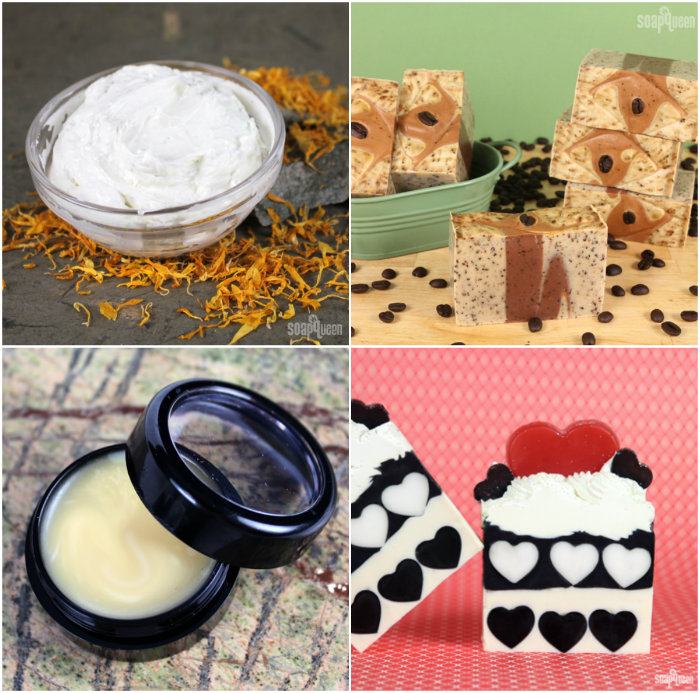 Top left, clockwise: Bramble Baby Belly Butter, Espresso Shot Cold Process Tutorial, Queen of Hearts Cold Process Soap, Vanilla Latte Lip Balm
Top left, clockwise: Bramble Baby Belly Butter, Espresso Shot Cold Process Tutorial, Queen of Hearts Cold Process Soap, Vanilla Latte Lip Balm
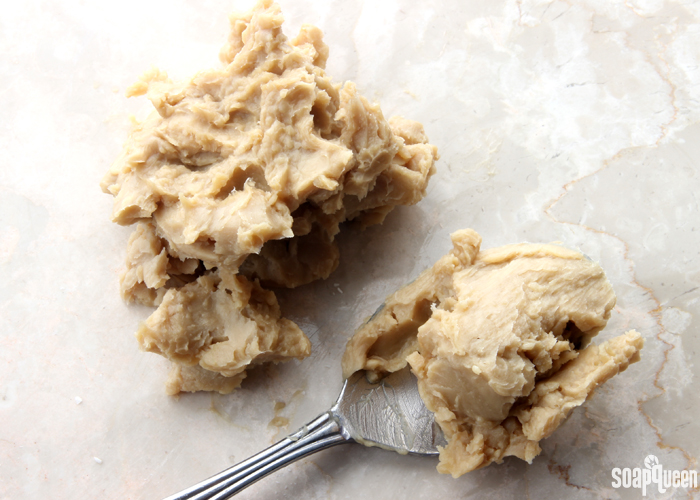 Coffee butter is a soft and smooth butter. It is similar in texture to avocado butter. It has a soft brown color and a rich coffee scent. It’s a blend of hydrogenated vegetable oil and coffee seed oil. It naturally contains .5%-1% caffeine. Coffee butter has a melting point of about 104° F.
Coffee butter is a soft and smooth butter. It is similar in texture to avocado butter. It has a soft brown color and a rich coffee scent. It’s a blend of hydrogenated vegetable oil and coffee seed oil. It naturally contains .5%-1% caffeine. Coffee butter has a melting point of about 104° F.
Because it’s nice and soft, it’s great for whipped butters. When using coffee butter in your skin care recipes, keep in mind that the natural smell will end up in the final product. If you love all things coffee, this is good news! I used coffee butter in both the Coffee Butter Foot Creme and and the Whipped Coffee Butter Tutorial. The butter adds a soft scent in these recipes, and contributes to a soft and smooth texture. I love the whipped texture of coffee butter so much, I also used it in the Pumpkin Spice Latte Sugar Scrub Soap Queen TV video below.
In cold process soap, I recommend using coffee butter around 3-6% of your recipe. Because of its soft texture, it does not add very much firmness or lathering properties to your recipe. Instead, it adds skin-loving conditioning properties. Coffee butter has a shelf life of about about 1 year.
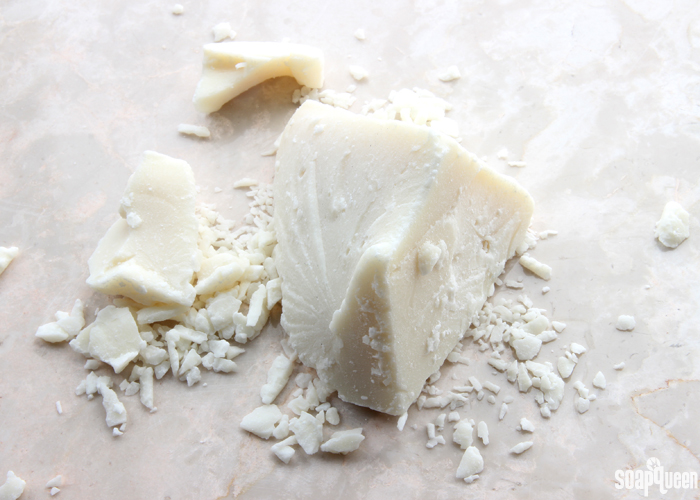 Mango butter has a firmer texture than shea, avocado and coffee butters, but is softer than cocoa butter. It is extracted from the fruit kernels of the mango tree, and begins to melt upon contact with the skin. Most mango butter on the market is refined and deodorized to remove scent and color. It has a melting point of about 86° F, and a shelf life of about 1 year.
Mango butter has a firmer texture than shea, avocado and coffee butters, but is softer than cocoa butter. It is extracted from the fruit kernels of the mango tree, and begins to melt upon contact with the skin. Most mango butter on the market is refined and deodorized to remove scent and color. It has a melting point of about 86° F, and a shelf life of about 1 year.
The medium texture (not too soft, not too hard) makes it a go-to choice for many crafters. In soap, I recommend using it at 15% or less of the total oils in your cold process recipe. When too much is used, it can cause the soap to crack or become brittle. Mango butter contributes a small amount of firmness to soap, but not nearly as much as cocoa butter.
Due to the slightly firm texture of mango butter, I prefer to add it to products in melted form. It’s not the best butter choice if you’d like to whip the butter; I recommend melting it first and whipping it as it cools. Check out the recipes below for mango butter ideas!
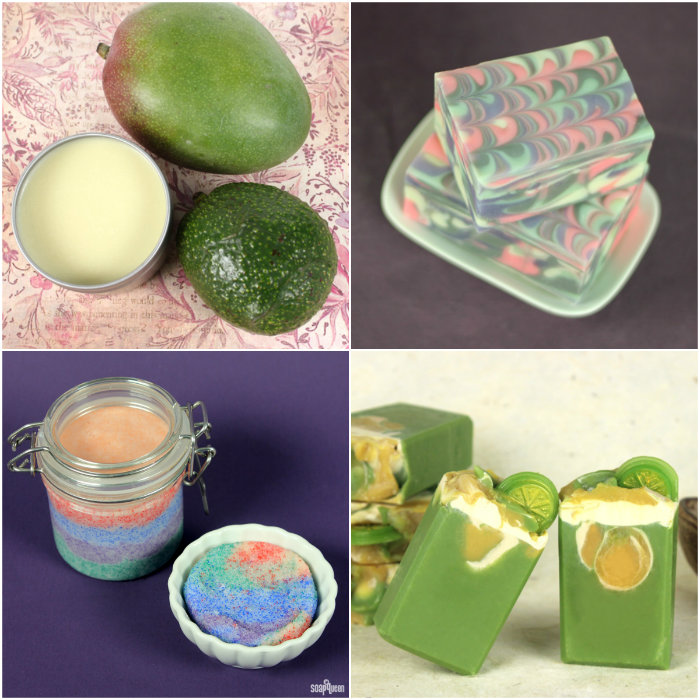 Top left, clockwise: Mango Avocado Balmy Salve, Butterfly Swirl Soap Tutorial, Lime in the Coconut Milk Cold Process Tutorial, Rainbow Jojoba Bead Sugar Scrub
Top left, clockwise: Mango Avocado Balmy Salve, Butterfly Swirl Soap Tutorial, Lime in the Coconut Milk Cold Process Tutorial, Rainbow Jojoba Bead Sugar Scrub
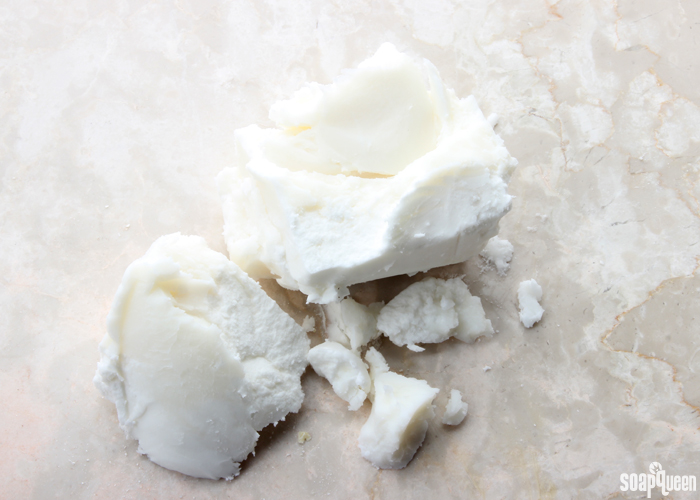 Last but certainly not least is shea butter. Shea butter is obtained by cold pressing the seeds of the karite tree. The shea butter found at Bramble Berry is ultra-refined for a neutral smell and pale color. Shea butter has a softer texture than cocoa and mango butter, but is slightly firmer than avocado and coffee butter. It has a shelf life of about 1 year, and a melting point of about 90° F.
Last but certainly not least is shea butter. Shea butter is obtained by cold pressing the seeds of the karite tree. The shea butter found at Bramble Berry is ultra-refined for a neutral smell and pale color. Shea butter has a softer texture than cocoa and mango butter, but is slightly firmer than avocado and coffee butter. It has a shelf life of about 1 year, and a melting point of about 90° F.
This skin-loving butter is usually used at 15% or less of the total oils in your cold process recipes. It contributes a bit to bar hardness and conditioning properties but does not help with lather. The soft texture makes it great for creating whipped body butters, as shown in the Easy Whipped Shea Butter. It’s also fantastic in lotion and lotion bars. Check out the tutorials below for projects using shea butter.
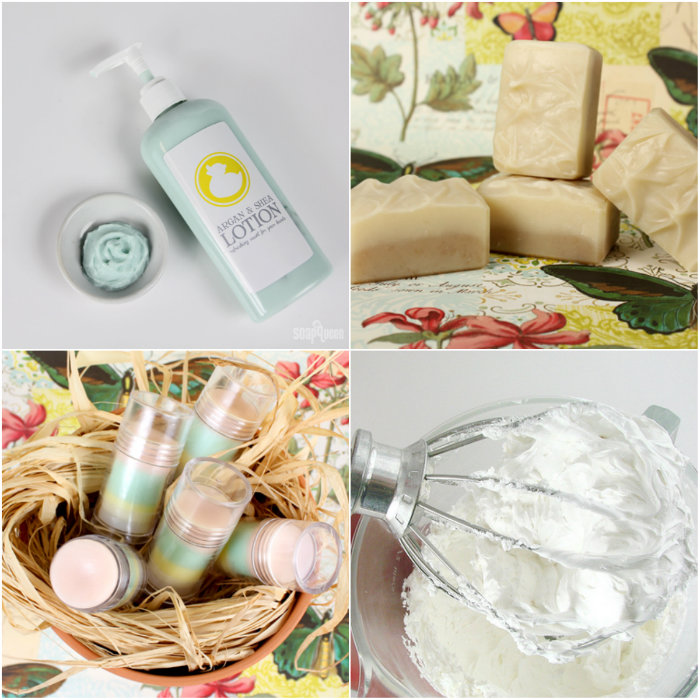 Top left, clockwise: Argan & Shea Lotion, Loofah Cold Process Soap Tutorial, Easy Whipped Shea Butter, Lotion Bar Love
Top left, clockwise: Argan & Shea Lotion, Loofah Cold Process Soap Tutorial, Easy Whipped Shea Butter, Lotion Bar Love
If you’re looking for more resources and information on using butters in your products, check out the blog posts below! What is your favorite butter? If I had to choose…I think I’d go with Shea Butter. =)
Free Beginner’s Guide to Soapmaking: Common Soapmaking Oils
Soaping in the Summer Heat
Sunday Night Spotlight: Cocoa Butter
Sunday Night Spotlight: Shea Butter
How to Create Lip Product Recipes
All About the Trace
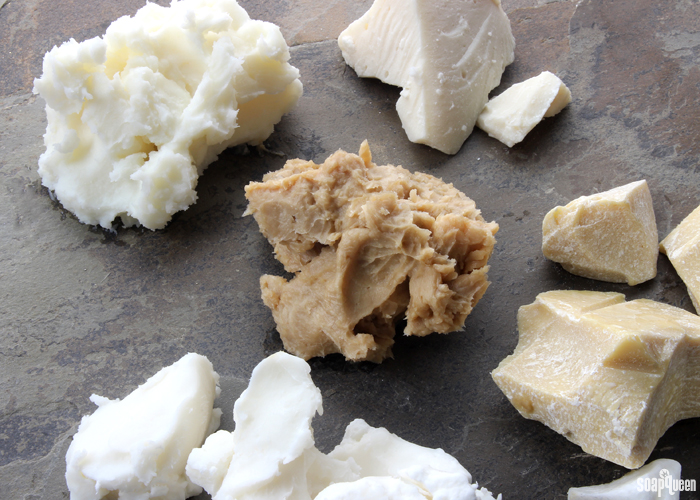

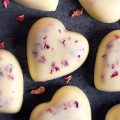



Hi! What would your suggestions be for Sal Butter (Shorea Robusta)? I have read that it is a wonderful butter for lotions and creams but I am not able to find much information about this butter. Can you please advise if you have tried this in any of your recipes?
-Thank you 🙂
We haven’t worked with that butter a lot so I’m not entirely sure. I would recommend making a small test batch with it to see what you think of the consistency.
Hi! Do you add butters before or after adding the lye? I just purchased some mango butter to harden my soaps and would like to know if I need to add it to my other oils. I use a blend of sunflower oil, olive oil, coconut oil and castor oil.
You can add that butter in with the rest of your oils. We like to heat the liquid oils together, then add the butter to those and stir well. That heats the butter gently, which helps prevent graininess. If it doesn’t melt fully, pop the oils back into the microwave and heat on 10 second bursts until it does. Then, once your lye and oils are around 100-130F, you can start emulsifying.
Learn more about preventing graininess in your butters here: https://www.soapqueen.com/bath-and-body-tutorials/tips-and-tricks/soaping-in-the-summer-heat/
Hi! I know I’m late to this party. But if you’re making soap with it, you have to add it before the lye. The lye is what saponifies the oils/ butters (changes it into soap). If you add it after the lye then it won’t be changed into soap.
Hii Kelsey,
Can we use body butters in melt n pour soap based, what would be the percentage and lastly what about their shelf life??
I just love watching your videos. You are truly inspirational.😍
We don’t recommend adding extra oil to the melt and pour bases. Because they already turned into soap, the extra oil can make them soft and inhibit lather. If you do add extra oil, we recommend no more than 1 teaspoon per pound of soap. That will give you the benefits without affecting the texture too much. 🙂
We also have lots of bases to choose from! You can select the one that best works for your skin type. Learn about our bases here: https://www.soapqueen.com/bath-and-body-tutorials/tips-and-tricks/sunday-night-spotlight-melt-and-pour-bases/
-Kelsey with Bramble Berry
Thank u sooo much..!
Hello I just came across this. I’ve been trying to research for awhiloed lotion I can use only one year old before bed time and am wondering if there’s any you recommend (I’m not sure if they’re all safe for children)? It seems most recipes I find are calling for shea butter, coconut oil, and some even vitamin E and arrowroot or cornstarch.
Thoughts?
Thanks!
All of our recipes are skin safe and can be used by children. To be extra safe, you can make them without fragrance and color just in case of any sensitivities. Body butters/balms are another option – they are made with just oil and butter and are super moisturizing on the skin. I’ll link a few recipes you may like below.
Frankincense Essential Oil Body Balm: https://www.soapqueen.com/bath-and-body-tutorials/lotion/frankincense-essential-oil-balm/
Cocoa Butter Cashmere Body Mousse: https://www.soapqueen.com/bath-and-body-tutorials/cocoa-butter-cashmere-mousse/
Green Smoothie Whipped Body Butter: https://www.soapqueen.com/bath-and-body-tutorials/green-smoothie-whipped-body-butter/
-Kelsey with Bramble Berry
Hello,
I am a beginner and have been experimenting with unrefined shea butter. I recently whipped up a few sample batches of shea butter and added the following carrier oils: coconut, sweet almond, castor, vitamin E, rosehip seed, and tamanu oils. I also added peppermint and rosemary essential oils also. I used this as a sealant for my naturally curly hair and experimented and made another batch also with shea and coconut, almond, and vitamin E oil as a body butter. My family and I don’t mind the greasy feeling as we actually love it on our skin and so does our friends. Should I be worried about adding a preservative to my mixture and how long will the product keep.
That sounds so nice and moisturizing! Because your recipe contains only oils and butter, it doesn’t need a preservative. Preservatives are needed if the recipe has water (lotion) or is stored in a wet area (a scrub kept in the shower). Learn more about preservatives here: http://www.soapqueen.com/bath-and-body-tutorials/lotion/talk-it-out-tuesday-preservatives/
-Kelsey with Bramble Berry
Thanks for the feedback Kelsey! It’s good to know that my Shea Butter Cream doesn’t need a preservative as I’ve sent some to my family and friends to try out and don’t want to harm them. 😊 As I previously stated, I used the first mixture mentioned as a sealant for my naturally curly hair and used grapefruit, lemon, and sweet orange essential oils because I love citrusy smelling products. What essential oils do you recommend me using for the buttercream when using on naturally curly hair so that it won’t dry the hair out. Eventually, I will be selling my mixtures and want to know what your stance is on replicating your buttercreams, soaps and lotions, etc. for profit.
You can use any essential oils you like for your butter cream! They will feel great in the recipe. You’ll want to avoid cinnamon or clove though. They can cause irritation in leave on products. Find our essential oils here: https://www.brambleberry.com/Essential-Oils-C157.aspx
And find out how much to add with our Fragrance Calculator: https://www.brambleberry.com/Pages/Fragrance-Calculator.aspx
-Kelsey with Bramble Berry
What is the best way to clean up after using butters and beeswax. Cant seem to get my tools and glass measuring cups clean. Have tried hot water and plenty of soap and hot dishwasher. Just seems to smudge around. This is my first time using these products.
Cleaning up butters and beeswax can definitely be tricky! It’s best to start cleaning the containers out when the wax/butters are still warm. That way you can wipe away as much as possible with a paper towel. If they’re solid, microwave the container for a few seconds to remelt. Then, spritz the containers liberally with rubbing alcohol and wipe with a paper towel again. It’s easier to get most of the wax off before cleaning with warm water and dish soap. That should make the process a bit easier. 🙂
You can also use melt and pour to clean the containers! Learn how here: https://www.soapqueen.com/bath-and-body-tutorials/lip-products/clean-oily-containers/
-Kelsey with Bramble Berry
I will be making whipped body butter for the first time, after watching Anne Marie’s post. now I going to order mango butter. cross my fingers I do it right. post.
Have fun Sarah! Body butter feels so nice on the skin. I would recommend melting the mango butter before whipping it. It’s a bit too firm at room temperature to whip. 🙂
Mango butter: https://www.brambleberry.com/Mango-Butter-P3221.aspx
-Kelsey with Bramble Berry
Hi I found a lotion recipe from you tube that sends me here (soap queen) that calls for Shea butter, coconut oil, argan oil, vit e,cacao butter and mango butter and lavender eo. Please help! It looks amazing and I would love to try it, but don’t have the cuantities.
Hi Eri!
Hmm, I’m not familiar with a recipe like that on our blog. The closest one I could find is the Argan and Shea Lotion: https://www.soapqueen.com/bath-and-body-tutorials/lotion/argan-shea-lotion/
Do you know the name of the recipe they recommended? Let me know!
-Kelsey with Bramble Berry
Hi, if I want to use triple butter in my cp soap (shea, cocoa and mango), how many percent of total or each do you think is best? Thank you. 🙂
Hi Fitri!
It’s definitely personal preference! We recommend using butters up to 15% in the recipe. So, you could do all three butters at equal amounts – 5%, 5% and 5%. Shea butter is a bit softer than cocoa and mango, so if you like a softer bar you can add more shea. On the other hand if you prefer a firmer bar, you can add more mango or cocoa butter. I would recommend a small test batch with several variations to see which one you like best! 🙂
-Kelsey with Bramble Berry
I have made a lavender body butter but for some reason it is not holding its shape after whipping it.IT has equal parts of shea ,coconut,and sweet almond oil.
Hi Debbie!
That recipe sounds really nice, and the hard butters should help it hold its shape! Do you live in a fairly hot and humid climate? Because the butters melt at hotter temperatures, that may be why the recipe isn’t holding its shape. Read more about that here: https://www.soapqueen.com/bath-and-body-tutorials/tips-and-tricks/soaping-in-the-summer-heat/
Let me know and we’ll get this figured out. 🙂
-Kelsey with Bramble Berry
Hello everyone. I would like to ask about butters such as coffee, oat, I’ve even seen jojoba butter. I recently purchased some oat butter but I’m not sure how to list it on a soap calculator. Do I list it as vegetable oil? Or say I was using jojoba butter. Would I put it under jojoba oil or vegetable oil? Thanks again!
Hi Maggie!
We haven’t done a lot of experimenting with those butters, so I’m not entirely sure! The SAP value may be a bit different between the oil and the butter. I would recommend contacting the manufacturer to see if they have that SAP value.
Once you have the SAP value, you can calculate how much lye you’ll need using the formula in this post: http://www.soapqueen.com/bath-and-body-tutorials/tips-and-tricks/free-beginners-guide-to-soapmaking-common-soapmaking-oils/
You can also use an oil with a similar SAP value in the calculator. The post above has SAP values listed at the bottom. For instance, if the jojoba butter has a SAP value of .135, you can enter in apricot kernel oil on the calculator. That’s a nice option if you’re not a fan of math (like me!) 🙂
-Kelsey with Bramble Berry
For soap, I use Shea butter almost exclusively. My standard recipe is 35% olive oil, 35% coconut oil, and 30% Shea butter. Everyone goes crazy over this soap. Expensive, yes. But I don’t sell, I give to friends and family as gifts.
That sounds like an awesome recipe! I love the creamy, moisturizing feel shea butter adds to the soap. Your friends and family are very lucky to get the bars! 🙂
-Kelsey with Bramble Berry
Yes! I totally disagree with the 10-15% or less of butters in a recipe too! I use 30% cocoa butter. With 30% coconut oil it lathers great. I also put in a small % of castor oil for lather. No problems with cracking. In experiments I only started having cracking bars at near 50% cocoa butter. 🙂
You can’t buy 30% butter bars on the market so I’m making a product for family and friends they can’t get any where else.
The great thing about making soap is that everyone’s perfect recipe is a little different! We recommend 10-15% butter if you’re just starting out, but as you get more comfortable you can definitely experiment and find your perfect percentage. That’s what’s so awesome about making soap – the ability to customize. 🙂
-Kelsey with Bramble Berry
Do you have a recipe for a body butter in the summer? I live in a very hot climate where temps can get up to 100+ in the summer. I find the normal body butters melt completely in the summer and in transit.
Thanks!!
Hi Manjari!
In hot weather, those butters can melt. However, there are several things you can do to keep them cool in transit! For instance, you can pack the butters with ice packs and thermo cases. You can also arrange a time for your product to deliver to your customers, that way it’s not sitting in the sun for several hours. Read more tips in the Soaping in the Summer Heat post: http://www.soapqueen.com/bath-and-body-tutorials/tips-and-tricks/soaping-in-the-summer-heat/
It can also help to make a recipe with butters that have higher melting points. For instance, cocoa butter has a melting point of 100F, and coffee butter melts around 104F. We used those butters in our Whipped Amber Bronzing Butter: http://www.soapqueen.com/bath-and-body-tutorials/lotion/whipped-amber-bronzing-butter/
That butter feels really great on the skin, and may hold up a little better in hotter temperatures. 🙂
-Kelsey with Bramble Berry
I’ve been working on some soap recipes that are for aging damaged skin. I’ve read a lot of positive things about Tamanu Oil. My question is for not only this oil, but also for other oils and butters. Do the healing properties of these oils become lessened with the heat from the saponification process? Many of the more “exotic” oils come with a big price tag. I’d hate to ruin the healing properties of them, during the process. Would making a salve or lotion with them keep more of the restorative properties, intact?
Hi Dawn!
That’s a great question! It’s tough to say if the properties of the oil make it through the saponification process. Cold process soap is a really harsh environment with a lot of pH changes! Because of that, some of the properties with the oils may not make it through. I can tell you certain oils and butters do make a difference in the feel of the soap. For instance, avocado butter adds a lovely creamy feeling to the soap. We’ve also used tamanu oil in soap before and it felt awesome: http://www.soapqueen.com/bath-and-body-tutorials/cold-process-soap/wild-leopard-print-cold-process-tutorial/
To be on the safe side, you may want to use those oils in a balm or a salve. That way you know the properties of the oil make it through. We have some awesome butters and balms made with tamanu oil. I’ll include links below. 🙂
Bramble Baby Belly Butter: http://www.soapqueen.com/bath-and-body-tutorials/bramble-baby-belly-butter/
Whipped Coffee Butter: http://www.soapqueen.com/bath-and-body-tutorials/lotion/whipped-coffee-butter-tutorial/
Everything Balm: http://www.soapqueen.com/bath-and-body-tutorials/lotion/tutorial-for-everything-balm/
Healing Under Eye Serum: http://www.soapqueen.com/bath-and-body-tutorials/soaks-and-scrubs/healing-eye-serum/
-Kelsey with Bramble Berry
Kelsey, Thank you for the information and the recipes. I will be trying some of these this weekend. Should be fun!
You’re welcome! Sounds like a good weekend to me. 🙂
-Kelsey with Bramble Berry
HI! Can raw Shea Butter be used in CP soaps, M&P soaps, lip balm, or scrubs? I was recently advised that ultra refined she butter removes the essential properties,
Thanks!
Hi Tanya!
You can use raw shea butter in your products if you like! Raw shea butter is darker in color, has a slightly nutty/smoky smell and has a shorter shelf life. That’s something to keep in mind when crafting with it!
We use refined shea butter and essential oils together frequently and haven’t noticed it diminishing the smell at all! I would recommend giving raw shea butter and refined shea butter a try to see what you think. That way you know which one you like best. 🙂
Shea butter: https://www.brambleberry.com/Shea-Butter-P3220.aspx
-Kelsey with Bramble Berry
Hi, I’m a new beginner for cold process soap. I want to experiment making vapor rub. I understand that one of the ingredients is beeswax. If I do not have that, can it be substitute with candellilla wax?
Just wondering if you have any tips on making vapor rub and like what type of EO should I add in besides Eucalyptus oil?
With love
Y
Hi Yati!
I can definitely offer some tips! From what I recall, the texture of vapor rub is sort of soft and gel like. Cera bellina wax would be perfect for that. It has a gel like texture that’s nice and spreadable. Our Argan and Ginseng Gentle Eye Serum feels similar to vapor rub and is nice and gentle on the skin: http://www.soapqueen.com/bath-and-body-tutorials/argan-ginseng-gel-eye-serum-on-soap-queen-tv/
Cera bellina wax: https://www.brambleberry.com/Cera-Bellina-Wax-P5642.aspx
As for the essential oils, I did a quick internet search and it looks like it often contains eucalyptus, but I also saw other recipes online that used peppermint essential oil and rosemary oil. You can add those if you like as well. 🙂
Eucalyptus essential oil: https://www.brambleberry.com/Eucalyptus-Essential-Oil-P3818.aspx
Peppermint essential oil: https://www.brambleberry.com/Peppermint-Essential-Oil-2nd-Distill-P3832.aspx
Rosemary essential oil: https://www.brambleberry.com/Rosemary-Essential-Oil-P3817.aspx
This blog post talks about how to blend essential oils safely and is really helpful: http://www.soapqueen.com/bath-and-body-tutorials/tips-and-tricks/how-to-blend-essential-oils-safely/
-Kelsey with Bramble Berry
From personal experience mango butter turns a very bright yellow when exposed to lye. I have substituted it for shea butter in several recipes that I had previously made with shea butter, adjusting for the lye of course, and the recipe went from off white to bright almost florescent yellow. I have not used coffee or avocado butter before, but I love the others.
Hi Lois!
Oh that’s strange! In our tests and recipes, we’ve found the mango butter stays a fairly neutral color in soap. You can see that color in the Gold Mine Cold Process Soap: http://www.soapqueen.com/bath-and-body-tutorials/gold-mine-cold-process-soap-tutorial/
Other factors can cause a yellow discoloration, including fragrance oil! Can you tell me a bit more about your recipe? Thanks so much Lois. 🙂
-Kelsey with Bramble Berry
I probably use Shea the most, but I love Cocoa the most just because of its scent (I get regular, not deodorized). 🙂
Shea and cocoa feel awesome in soap! They make it feel so luxurious. 🙂
-Kelsey with Bramble Berry
Thanks for another great resource! I always like to see the new projects, but I think I like the informational posts just as much.
You’re welcome Michael, so glad you enjoy this post! 🙂
-Kelsey with Bramble Berry
So hydrogenation is really a process of taking unsaturated fats (your liquid oils) and converting them into saturated (well, realistically, mostly saturated-it’s difficult to make every unsaturated portion of the oils saturated but that’s another day for chemistry!) oils/butters. This saturation process is where we are “adding hydrogen” to the oils. When this process occurs, it changes the properties of the oil: the more saturated a hydrocarbon chain (i.e. oils/butters), the higher the melting point. Thus, you get a solid oil, or, butter in this case.
Thanks so much for your thoughtful comment Addi! It’s nice to know the more detailed process of how oils are hydrogenated. 🙂
-Kelsey with Bramble Berry
This is a great roundup of products! I love the whipped butter teacher Lori makes – it’s awesome! It has mango, shea & cocoa butters in it.
Thanks so much! The whipped butter sounds awesome. 🙂
-Kelsey with Bramble Berry
I love Mango butter in lotions! I find that shea is a little too greasy and takes longer to sink in. The kind I have does have a very light mango seed scent (I grew up with 2 mango trees in my childhood yard) that does not carry over to any product it is used it. I add mango and shea to all my soaps for a touch of luxury 🙂
Mango butter feels awesome in lotions, it’s so nice and moisturizing! Definitely a great way to add a bit of luxury. 🙂
-Kelsey with Bramble Berry